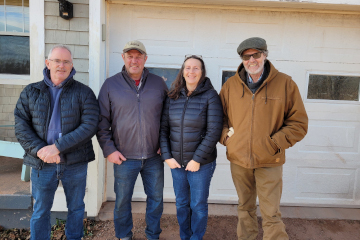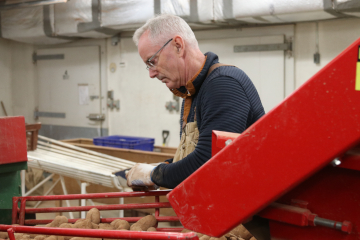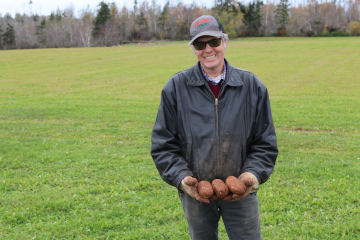
From summer through fall, Agriculture and Agri-Food Canada researchers (AAFC) challenged Canadian farmers to answer the question – what would the potato yield be if they were grown only using the nitrogen leftover from the previously harvested crop and a cover crop?
Now, the results from the #AAFCPlowdownChallenge are in! Researchers and farmers might be surprised by the answer.
Scott Anderson, AAFC science coordinator, and his team planted the Mountain Gem potato variety on a field at the AAFC Harrington Research Farm this summer and farmers were encouraged to guess what the yield would be after harvest and grading, which was completed mid-November. There was a catch – the potatoes were grown without applying any fertilizer. The field was planted with red clover last summer, then a barley cover crop planted last fall, with soil and plant stalk testing completed regularly. Scott and his team wanted to demonstrate the value of considering the nutrients leftover in the soil from a properly managed previous crop and cover crop to ensure efficient fertilizer-use.

The actual potato yield after harvesting the #AAFCPlowdownChallenge fields at the AAFC Harrington Research Farm on Prince Edward Island was 169 hundredweight per acre. That is compared to the provincial average of 311 hundredweight per acre of potatoes in 2023. Scott and his team were excited by the amount and size of the potatoes harvested from the research plots.
“This yield result is very good, in our opinion. It shows the ability of the soil to provide nutrients from a previous crop, like red clover, to help grow potatoes,” says Scott.
Prince Edward Island cattle farmer, Paul Smallman, was the winner of the challenge with the closest guess of 177 hundredweight per acre. Island potato farmer, Kevin Murray was the runner-up, with a guess of 117 hundredweight per acre.
“In the past, I’ve planted red clover which adds nitrogen to the soil naturally, and I also use manure,” explains Paul. “I figured without manure, the yield would be half of what it normally would be, and I was pretty close!”

“We hope this will continue to educate farmers on the benefits of factoring in the leftover nitrogen from the previous crops or cover crops, through soil testing, and then applying fertilizer more efficiently in potato crops,” says Scott. “It could help them save money, and they’ll help the environment, too.”
This initiative is one of the many ways AAFC and farmers are continuing to act as stewards of the land, working towards an even more sustainable agricultural sector. Considering leftover nutrients in the soil when making decisions on fertilizer-use can be added to the toolbox for farmers along with other AAFC-researched beneficial management practices such cover crops and enhanced efficiency fertilizers.
Learn more about environment and sustainability in agriculture.
Get more Agri-info
- Want more stories like this? Explore what else Agri-info has to offer.
- Interested in reporting on this story? Contact AAFC Media Relations at aafc.mediarelations-relationsmedias.aac@agr.gc.ca to arrange an interview with one of our experts.
- Have a story idea or feedback to share? Get in touch at aafc.agri-info.aac@agr.gc.ca!